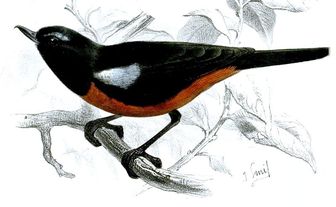Merida flowerpiercer
Its natural habitats are subtropical or tropical moist montanes and subtropical or tropical high-altitude shrubland.

The Merida flowerpiercer is classified as Least Concern. Does not qualify for a more at risk category. Widespread and abundant taxa are included in this category.
Merida Flowerpiercer already in front of the car, and while walking down now into the upper elfin forest we added Glossy and Moustached Flowerpiercer. Here we also had the first of many Lacrimose Mountain-Tanagers, and heard Merida Tapaculo. Another nice bird was Slaty Brush-Finch. Now (at GPS228) we had walked less than 1 km, and were deeper down into the bamboo-rich elfin forest. We heard two Ocellated Tapaculos (a bird with a very local occurrence, possibly in small colonies acc. More
afternoon - Merida Flowerpiercer (frankly one of the top flowerpiercers out there). We then climbed higher to search for our two final targets of the afternoon. Well above the treeline in the Andes, the trees give way to high-altitude wet grasslands, or paramos, as they are known in the northern Andes. These can be really unforgiving environments at around 4000m with little shelter and prone to regular inclement weather. In short the kind of environments where one would never expect to find birds like hummingbirds. More
Family : Thraupidae
Genus : Diglossa
Species : gloriosa
Authority : Sclater & Salvin, 1870

